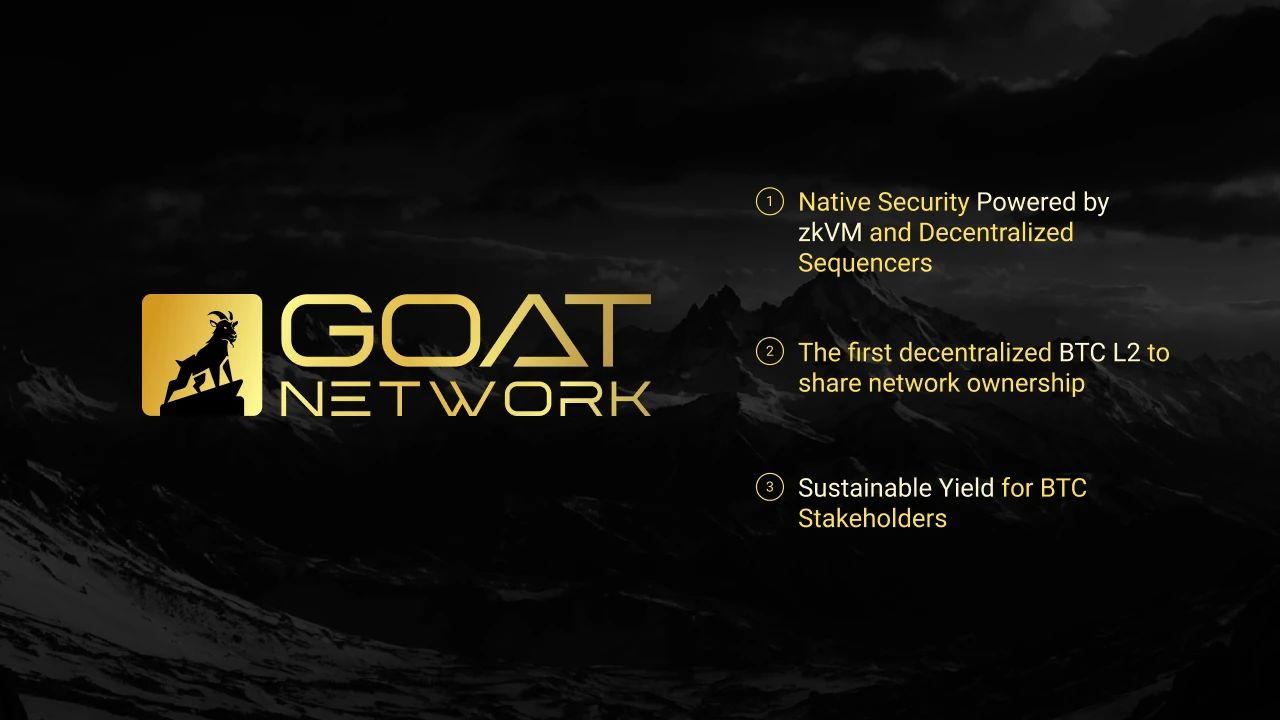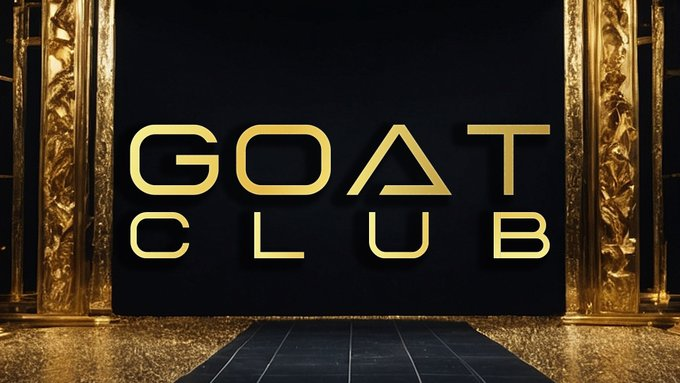TLDR:
GOAT Network will launch its testnet this month and the mainnet is expected to go live in Q3.
It has secured a commitment of 5000 BTC for liquidity when the mainnet goes live, with the initial nodes including Amber Group, Hashkey Cloud, RockX, Benmo, and an undisclosed operator.
GOAT Network addresses the three major challenges faced by L2: decentralization, security, and sustainable revenue. Its vision is to become a universal L2 for all L1.
Early users can earn points through the GOAT Club program, which can be used to receive upcoming airdrops.
As the Bitcoin ecosystem continues to develop and improve, the construction of the BTC ecosystem has become an important narrative of Web3 in 2023 and 2024.
Layer2 built on BTC is indispensable in the BTC ecosystem construction and is the most important part. Data shows that BTC L2 companies and projects raised $94.6 million in Q2 2024, a 174% increase compared to the previous quarter, demonstrating strong expectations for BTC Layer2 within the industry.
Currently, there are numerous solutions for BTC Layer2, but there has not been a project with both excellent technology and ecosystem. This track is still in the stage of fierce competition, and any high-quality project has the opportunity to become a leader, attracting the majority of users and funds.
Among the many BTC Layer2 solutions, GOAT Network is the most innovative and promising project, and it is the first network to adopt a decentralized sequencer and share network ownership in the BTC Layer2. Its ultimate goal is to become a universal L2 for all L1.

This article will comprehensively present GOAT Network from the perspectives of background, technology, ecosystem, and team.
About GOAT Network
GOAT Network expands the functionality of Bitcoin by implementing Bitcoin Rollup, and the security of the network is obtained from the underlying Bitcoin blockchain, which is L1.
By introducing an optimistic challenge protocol, GOAT-OCP, and utilizing BitVM2 to ensure security, as well as intertwining ZKM Rollup as a universal settlement layer, GOAT Network can enhance the inclusiveness and finality of transactions. It also uses a decentralized sequencer to protect the stability of the network and ensure the security of assets.
The GOAT testnet will be launched soon, and the mainnet is expected to go live in Q3 or Q4. The official will introduce the GOAT Club points program, providing sustainable and fair rewards for Bitcoin holders of all sizes.
Thoroughly Addressing the Three Major Challenges Faced by L2
All L2 networks face the challenges of decentralization, security, and achieving sustainable revenue. In response to these challenges, GOAT Network has proposed effective solutions:
Decentralized Sequencer
Currently, the majority of L2 networks use centralized sequencers. If the sequencer encounters problems, the entire system will be disrupted or even crash. This centralization poses security risks to the entire system, affecting the organic growth of the system.
GOAT will adopt a decentralized sequencer from the first day of the mainnet launch, initially with 7 sequencer nodes, each of which will need to pledge BTC to protect the GOAT network. As the ecosystem develops, more sequencers will join.
There are already 5 confirmed founding sequencer nodes, including Amber Group, Hashkey Cloud, RockX, Benmo, and an undisclosed operator, which have committed over 5,000 BTC, with the goal of reaching 8,000-10,000 BTC at launch. Deeper liquidity will help in the construction and operation of on-chain DeFi applications, while ensuring the stability and security of the network to the greatest extent.
One of the first sequencer operators, Amber, is an outstanding blockchain infrastructure provider and asset management company, and is one of GOAT's first investors. Amber is proficient in both technology and investment, and its investment projects have significant reference value for the crypto market.
Security
In terms of security, GOAT Network has applied enhanced versions of Bitcoin time locks and one-time signature technology to protect locked BTC assets at the Bitcoin L1 layer, similar to Babylon. At Layer2, it has applied zkVM, a zero-knowledge virtual machine developed by ZKM, to give the system native security standards at the Bitcoin base layer.
Sustainable Revenue Model
Decentralized sequencers can earn BTC gas fees and GOAT token mining rewards by generating blocks, providing security, and maintaining round-the-clock activity.
This mechanism provides opportunities for node operators, builders, BTC whales, and small holders to participate in sequencer operations and earn sustainable revenue.
This structure also tokenizes the income of decentralized sequencers, creating a new BTC bond market.
Universal Layer2 for all L1
GOAT Network aims to become a universal L2 for all L1, demonstrating its ambition and foresight.
Bitcoin is the first ecosystem integrated by GOAT Network, with plans for Ethereum, TON, Cosmos, and others in the future. The goal is to seamlessly connect any L1 to any L2, addressing blockchain interoperability and decentralized liquidity issues without traditional third-party bridges. Currently, no other L2 can achieve this.
Cross-chain interoperability is the most fragile layer in blockchain and is prone to security issues, causing significant losses. GOAT Network deploys its internal Entangled Rollup technology on the L1 and L2 of all blockchains, aggregating transaction states, message passing, and ZKP from one source chain for verification on another chain. This approach enables messaging and asset transfers across many different networks without the need for third-party bridges, ensuring smooth liquidity and asset security across the entire network. This also makes it possible for GOAT Network to become a universal L2 for all L1.
Team
The team is the soul of a project and the key to its success. Stephen Duan, the leader of the GOAT technical team, previously founded Baidu Blockchain and Eigen Network. The growth, development, and strategy team members have all led multiple well-known Web3 projects.
Projects that can operate in the long term have a common characteristic: sustainable token economics. Redouane Elkamhi, the economist of GOAT Network, is a finance professor at the Rotman School of Management, University of Toronto. Dr. Elkamhi has served as an advisor to KPMG and Ernst & Young. Elkamhi specializes in strategic asset allocation, fund management, and DeFi, and has designed a sustainable revenue mechanism for GOAT that covers nodes and BTC holders, with the final details to be expected.
Chief Innovation Officer Dr. Eric Wang holds a Ph.D. in Computer Science from the University of Waterloo and has extensive experience in traditional finance, specializing in derivatives pricing, dynamic asset allocation, risk management, and DeFi. He has designed a sustainable BTC revenue model for GOAT, applicable to node operators, BTC miners, large holders, and small holders.
The GOAT Network team has been transparent from day one and are long-term participants and innovative leaders in the Web3 field. Such a team and transparency enhance the credibility and future expectations of GOAT!
Conclusion
GOAT Network adopts a decentralized sequencer and shares network ownership from the first day of the mainnet launch, embodying true decentralization. It has already confirmed the participation of 5 institutional sequencer nodes, with a commitment of 5000 BTC for liquidity on the first day, providing deep liquidity for GOAT Network and ensuring fund efficiency.
In addition to technical and mechanism innovations, GOAT Network is building an organic ecosystem. Upon the mainnet launch, it will simultaneously introduce some key DeFi programs, including DEX, lending, Perp DEX, BRC-20, and a zero-fee trading platform for other Bitcoin native assets, even including a MEME center!

The GOAT Club points program is the best opportunity for early participation in GOAT Network, and point holders will be eligible for upcoming airdrops. There are three types of points:
Community Points (CP): Community members only need to hold 0.001 BTC to receive long-term rewards and points.
Builder Points (BP): Builders can receive additional rewards based on the TVL or gas consumption of their smart contracts, or by integrating the GOAT Club API with a custom points system to receive extra rewards from user activity at the mainnet launch.
Node Points (SP): Node operators earn points based on the blocks they produce, ensuring direct rewards for contributions to network activity and security.
Finally, we look forward to the launch of the GOAT Network mainnet and hope that GOAT can become a leader in BTC Layer2, bringing more use cases and benefits to BTC holders!
免责声明:本文章仅代表作者个人观点,不代表本平台的立场和观点。本文章仅供信息分享,不构成对任何人的任何投资建议。用户与作者之间的任何争议,与本平台无关。如网页中刊载的文章或图片涉及侵权,请提供相关的权利证明和身份证明发送邮件到support@aicoin.com,本平台相关工作人员将会进行核查。




